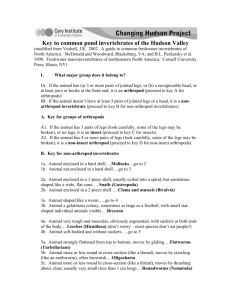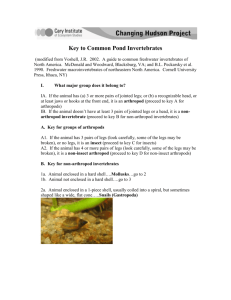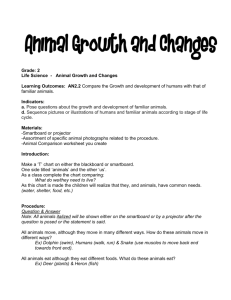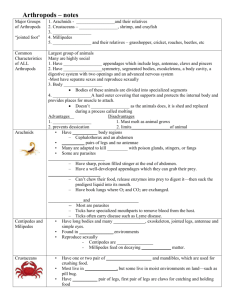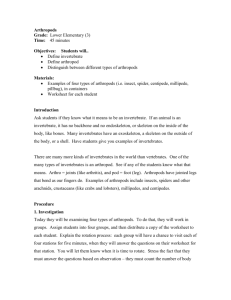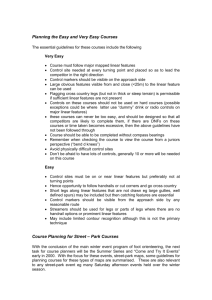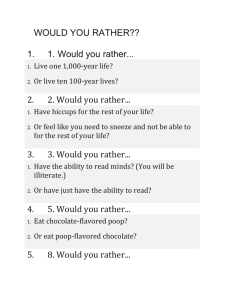Key with Pictures
advertisement
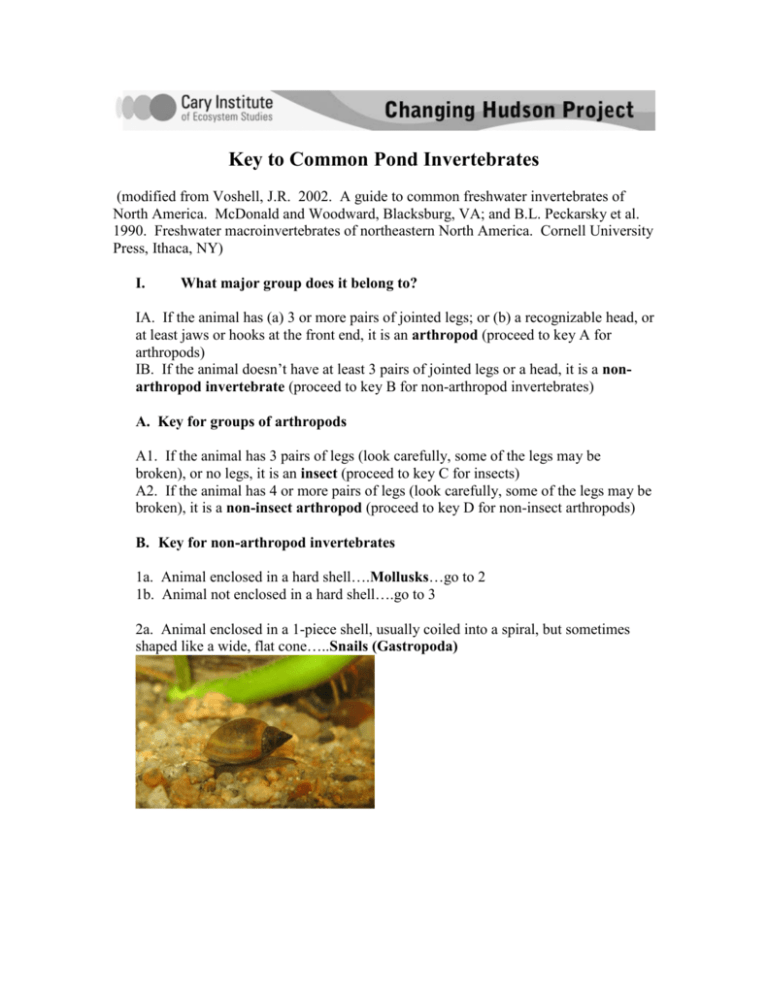
Key to Common Pond Invertebrates (modified from Voshell, J.R. 2002. A guide to common freshwater invertebrates of North America. McDonald and Woodward, Blacksburg, VA; and B.L. Peckarsky et al. 1990. Freshwater macroinvertebrates of northeastern North America. Cornell University Press, Ithaca, NY) I. What major group does it belong to? IA. If the animal has (a) 3 or more pairs of jointed legs; or (b) a recognizable head, or at least jaws or hooks at the front end, it is an arthropod (proceed to key A for arthropods) IB. If the animal doesn’t have at least 3 pairs of jointed legs or a head, it is a nonarthropod invertebrate (proceed to key B for non-arthropod invertebrates) A. Key for groups of arthropods A1. If the animal has 3 pairs of legs (look carefully, some of the legs may be broken), or no legs, it is an insect (proceed to key C for insects) A2. If the animal has 4 or more pairs of legs (look carefully, some of the legs may be broken), it is a non-insect arthropod (proceed to key D for non-insect arthropods) B. Key for non-arthropod invertebrates 1a. Animal enclosed in a hard shell….Mollusks…go to 2 1b. Animal not enclosed in a hard shell….go to 3 2a. Animal enclosed in a 1-piece shell, usually coiled into a spiral, but sometimes shaped like a wide, flat cone…..Snails (Gastropoda) 2b. Animal enclosed in a 2-piece shell…..Clams and mussels (Bivalvia) 3a. Animal shaped like a worm…..go to 4 3b. Animal a gelatinous colony, sometimes as large as a football, with small starshaped individual animals visible….Bryozoa 4a. Animal very tough and muscular, obviously segmented, with suckers at both ends of the body….Leeches (Hirudinea) (don’t worry – most species don’t eat people!) 4b. Animal soft-bodied and without suckers…..go to 5 5a. Animal strongly flattened from top to bottom, moves by gliding….Flatworms (Turbellarians) 5b. Animal more or less round in cross-section (like a thread), moves by crawling (like an earthworm), often brownish….Oligochaeta 5c. Animal more or less round in cross-section (like a thread), moves by thrashing about, clear, usually very small (less than 1 cm long)….Roundworms (Nematoda) C. Key for insects 1a. Without segmented legs…True flies (Diptera) 1b. With 3 pairs of segmented legs (some may be broken off!)…go to 2 2a. With large, functional wings….go to 3 2b. Without wings, or only with developing wingpads that couldn’t be used for flying…go to 4 3a. Hind wings formed into hard wingcovers; with chewing mouthparts….Beetles (Coleoptera) 3b. Only parts of the hind wings hardened; with sucking mouthparts…True bugs (Hemiptera) (watch out – some of these bite!) 4a. Animal small (less than 3 mm long), with a “spring” under the abdomen (hind part of the body)…Springtails (Collembola) 4b. Animal small or large, but never with a “spring” under the abdomen….go to 5 5a. Animal with 3 long “tails” (look closely – these may be broken off!)…go to 6 5b. Animal without 3 long “tails”…go to 7 6a. Tails as thin as a thread; animal with feathery gray gills on the sides of the abdomen…Mayflies (Ephemeroptera) 6b. “Tails” fleshy (these “tails” are actually gills); without gills on the sides of the abdomen….Damselflies (Odonata) 7a. Animal large and stout, with a long, extendable underjaw…Dragonflies (Odonata) 7b. Animal of various shapes and sizes, but never with a long, extendable underjaw…go to 8 8a. With sucking mouthparts in the shape of a long tube…True bugs (Hemiptera) (watch out – some of these bite!) 8b. With chewing mouthparts that are not shaped like a long tube…go to 9 9a. Animal living in a case made of sand, bits of leaves, etc.; antennae very small and hard to see…Caddisflies (Trichoptera) 9b. Animal free-living without a case; antennae usually clearly visible…Beetles (Coleoptera) or Alderflies (Megaloptera) D. Key for non-insect arthropods 1a. Animal ball-shaped, with 4 pairs of legs, often bright-colored, usually less than 3 mm long…Water mites (Hydracarina) 1b. Animal very small (less than 2 mm long)….go to 2 1c. Animal more than 2 mm long…..go to 4 2a. Animal enclosed in a flattened shell…go to 3 2b. Animal tear-drop-shaped or cigar-shaped, not enclosed in a flattened shell…Copepoda 3a. Animal shaped like a tiny seed, without a distinct head…Seed shrimp (Ostracoda) 3b. Animal with a distinct head or “nose:…Water-fleas (Cladocera) 4a. Animal large (more than 2 cm long), with obvious claws (watch out!)…Crayfish (Decapoda) 4b. Animal small (usually less than 2 cm long), without obvious claws…go to 5 5a. Animal flattened from side to side, usually yellow-brown…Scuds (Amphipoda) 5b. Animal flattened from top to bottom, usually gray…Sow bugs (Isopoda)
